
Karl Wilhelm Friedrich August Leopold Graf von Werder was a Prussian general.

The siege of Strasbourg took place during the Franco-Prussian War, and resulted in the French surrender of the fortress on 28 September 1870.
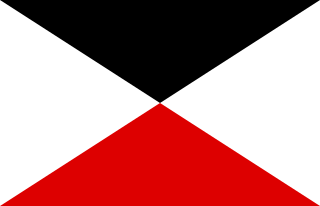
The XIV Army Corps / XIV AK was a corps level command of the German Army before and during World War I. It was, effectively, also the army of the Grand Duchy of Baden, which, in 1871, had been integrated into the Prussian Army command structure, as had the armies of most German states. Both divisions and the bulk of the corps' support units were from the grand duchy. The corps was established in 1870, after the Siege of Strasbourg.

The Army of the Vosges was a volunteer force placed under the command of Giuseppe Garibaldi, formed in order to ensure the defense of the road to Lyon from the Prussian Army during the Franco-Prussian war.

Athée is a commune in the Côte-d'Or department in the Bourgogne-Franche-Comté region of eastern France.

The Battle of Villersexel took place on 9 January 1871 as part of the Franco-Prussian War. Elements of the French Armée de l'Est under General Bourbaki engaged August von Werder's German forces. It resulted in a French victory.
The Battle of Châtillon, also known as the Battle of Châtillon-sous-Bagneux, was a skirmish in the Siege of Paris between France and North German Confederation in the Franco-Prussian War, took place on 13 October 1870. This is also considered the first battle in the history of the French Third Republic. In this fierce battle – occurred at Châtillon and Sceaux, Corps V of the Prussian army under the command of Lieutenant General Infantry Hugo von Kirchbach, along with the II Corps of the Kingdom of Bavaria by the Supreme Minister infantry Jakob von Hartmann which were the forces of the army Group 3 of Prussia by Prince Friedrich Wilhelm as General command., won a victory against an attack by the XIV Corps under General Renault - of the French army under General Auguste-Alexandre Ducrot. Although some soldiers under Ducrot fought well, the majority of his army became agitated. The French were forced to flee to Paris, losing the Châtillon Plateau - a very favorable defensive position overlooking the fortresses south of Paris - to the Germans. This was a disaster for the "justice" of the French army during the war, although the French reported that they suffered only minor losses.
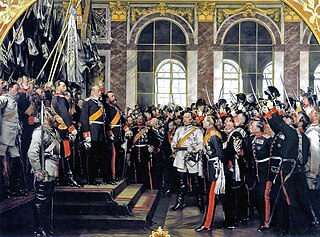
The proclamation of the German Empire, also known as the Deutsche Reichsgründung, took place in January 1871 after the joint victory of the German states in the Franco-Prussian War. As a result of the November Treaties of 1870, the southern German states of Baden, Hesse-Darmstadt, with their territories south of the Main line, Württemberg and Bavaria, joined the Prussian-dominated "North German Confederation" on 1 January 1871. On the same day, the new Constitution of the German Confederation came into force, thereby significantly extending the federal German lands to the newly created German Empire. The Day of the founding of the German Empire, January 18, became a day of celebration, marking when the Prussian King William I was proclaimed German Emperor at the Palace of Versailles.
The Podewils gun was a 13.9mm calibre rifle used in the Bavarian army since 1858. It was the most common infantry weapon of the Bavarian army in the Austro-Prussian war of 1866 and the Franco-Prussian war of 1870/71. Theodor Fontane called it an "excellent" weapon of the Austro-Prussian war due to its long range. Originally a muzzleloader, it was converted to breechloading in 1867, the so-called Lindner conversion. In 1869 the Bavarian army started to replace it with the Werder breechloader, but due to budgetary constrains by 1870 most Bavarian troops still used the Podewils while only four infantry battalions had received the Werder. Even the Lindner conversion was inferior to both the Prussian Dreyse needle gun and the French Chassepot.

The Battle of Werbach took place during the Austro-Prussian War as part of the Campaign of the Main on 24 July 1866 between the Prussian Alliance and the German Federal Army.
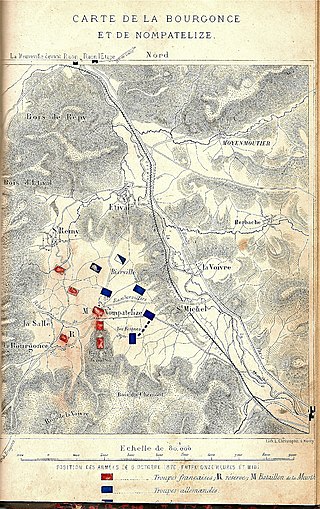
The Battle of Nompatelize, also known as the Battle of Etival, was a battle of the Franco-Prussian War on 6 October 1870, between Etival and Nompatelize in the province of Vosges from Strasbourg 64 km southwest. This battle marked the first major crackdown of franc-tireur operations in the Vosges region by the XIV Corps of the Prussians by Minister August von Werder in early October 1870. In matches fiercely this, A force of the Army of Rhône of the French Republic under the command of General Louis-François Dupré, who predominated to markedly document in terms of troop numbers, and attacked 6 infantry battalions of the Grand Duchy of Baden under the command of General Alfred von Degenfeld which were part of the XIV Corps, but were defeated. Compared to the casualties of the German military, the losses of the French side in this battle were much greater. After seven hours of fighting, the French were forced to flee in turmoil to Bruyeres and the Rambervillers. The Battle of Etival contributed to General Werder wiping out the French from Alsace.
The siege of Sélestat was a siege, extending from 20 to 24 October 1870, of the French Alsatian fortress of Sélestat, during the Franco-Prussian War. After artillery bombardment by the Germans, the siege ended when the French army surrendered, mainly because the French garrison was demoralized. The Germans suffered only minor losses, while this victory brought them many spoils.
The Battle of Ognon was a battle in the Franco-Prussian War, which took place on October 22, 1870, at the Ognon River. In this battle the Prussian XIV Corps under the command of General Karl August von Werder, which also consisted of a division of the Grand Duchy of Baden, attacked elements of the French Army of the Rhine commanded by General Albert Cambriels. The Germans captured a large number of French prisoners. The German victory in the Battle of Ognon decided the fate of the Army of the Rhine, at least within two weeks thereafter.
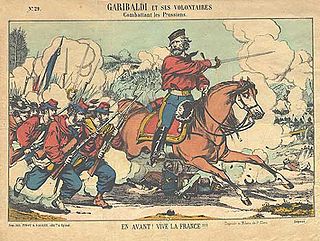
The Battles of Dijon were a series of battles that took place in 1870 and 1871, as part of the Franco-Prussian War, on the current territory of the French commune of Dijon between the French Republic and the German states of Prussia and Baden and later, the German Empire.
The Battle of Châteauneuf was a battle in the Franco-Prussian War that took place on December 3, 1870, at the Châteauneuf-sur-Loire, Loire, France. During this engagement, the 3rd Infantry Brigade of the Prussian army, which was a part of the Baden Division and was under the command of General Keller repelled an ambush of the French army under the command of General Camille Crémer. The battle facilitated the Prussian army to continue its withdrawal from Autun. The battle lasted for seven hours, and brought the Prussian army negligible losses, with 153 casualties. However, the Germans viewed this engagement as one of their most glorious victories of the campaign.

The Battle of Longeau, was a battle of the Franco-Prussian War on December 16, 1870 in Longeau-Percey, near Dijon, France. The fighting lasted about three hours, and ended in a French retreat. Victory went to the Prussian Infantry Brigade under Colmar Freiherr von der Goltz and the German XIV Corps infantry under the command of Lieutenant General August von Werder, over French troops commanded by General Pierre Arbellot de Vacqueur, semt from Langres to Longeau. The French suffered significant losses of both manpower and equipment.
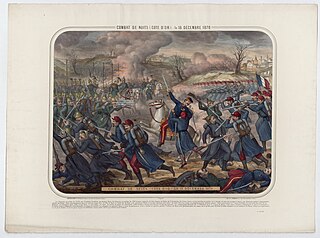
The Battle of Nuits-Saint-Georges was a battle in the Franco-Prussian War, which took place on December 18, 1870. In this battle, the Baden Division of Germany commanded by General Adolf von Glümer and the XIV Legion under the command of General August von Werder, has won the position in Nuits from the French army led by General Camille Crémer, forced the French army to withdraw overnight with heavy losses for both sides. Glümer himself was also slightly wounded in this engagement, while the defeat of the French army in the fierce battle at Nuits Saint George resulted in the loss of much of their equipment to the German army. Cremer is credited with fighting with great courage in this battle, but not with leadership.
The Battle of Monnaie, also known as the Battle of Tours was a battle of the Franco-Prussian War. It took place on the December 20, 1870 at Indre-et-Loire, France. During this engagement, a Hanover division of the Imperial German Army under the command of General Schwarzkoppen, belonging to Legion X under the command of Konstantin Bernhard von Voigts-Rhetz attacked and won the victory against an army of Garde Mobile's 234 led by General Ferry Pisani, driving the French to Langreais. This victory allowed the Germans to enter and occupy the city of Tours.
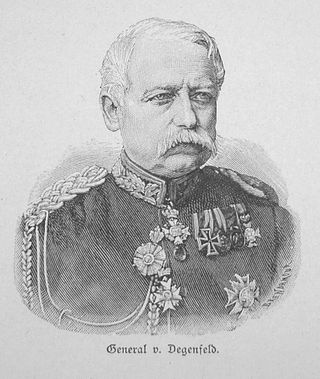
Alfred Emil Ludwig Philipp Freiherr von Degenfeld was a Badensian-Prussian general and a member of the Reichstag.
The Baden Army was the military organisation of the German state of Baden until 1871. The origins of the army were a combination of units that the Badenese margraviates of Baden-Durlach and Baden-Baden had set up in the Baroque era, and the standing army of the Swabian Circle, to which both territories had to contribute troops. The reunification of the two small states to form the Margraviate of Baden in 1771 and its subsequent enlargement and elevation by Napoleon to become the Grand Duchy of Baden in 1806 created both the opportunity and obligation to maintain a larger army, which Napoleon used in his campaigns against Austria, Prussia and Spain and, above all, Russia. After the end of Napoleon's rule, the Grand Duchy of Baden contributed a division to the German Federal Army. In 1848, Badenese troops helped to suppress the Hecker uprising, but a year later a large number sided with the Baden revolutionaries. After the violent suppression of the revolution by Prussian and Württemberg troops, the army was re-established and fought in the Austro-Prussian War of 1866 on the side of Austria and the southern German states, as well as in the Franco-Prussian War of 1870 on the side of the Germans. When Baden joined the German Empire in 1870/71, the Grand Duchy gave up its military sovereignty and the Badenese troops became part of the XIV Army Corps of the Imperial German Army.












